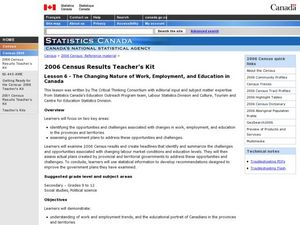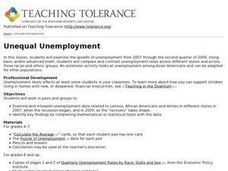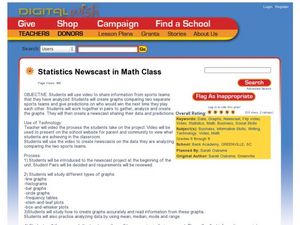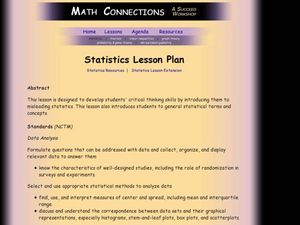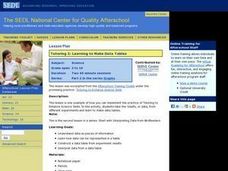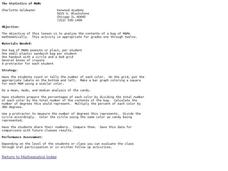Curated OER
Gender Issues through Chi-square Experiments
Learners investigate teachers and gender preference. In this statistic lesson, students collect data of teachers calling on learners to see if they are calling on one gender more than the other. Students examine the data and draw...
Curated OER
Gender and Income
Students investigate Income and gender preference. In this statistic lesson, students collect data of Income to see if one gender makes more than the other. Students examine the data and draw conclusions.
Curated OER
Youth vs. Adult Employment
Students investigate the unemployment rate in Canada. In this statistics lesson, students collect data on youth finding jobs, graph and analyze the data. This assignment raises awareness of the employment problems in Canada.
Curated OER
The Changing Nature of Work, Employment, and Education in Canada.
High schoolers identify the effect caused by change of employment and education. In this statistics lesson, students analyze data and draw conclusions. This assignment tests high schoolers' ability to use data correctly.
Curated OER
Unequal Unemployment
Students examine unemployment in the United States. In this statistics activity, students examine data and primary sources regarding unemployment in the United States.
Curated OER
Statistics Canada: Explore Perspectives
In this challenges and opportunities worksheet, learners explore perspectives as they complete a graphic organizer regarding trade certificates in mechanics.
Curated OER
Checking Test Comparability/Scattergrams
Students construct a scattergram graph. In this statistics lesson, students graph data by hand and using a spreadsheet program. They establish lines of best fit and draw conclusions using their graphs.
Curated OER
Statistics Newscast in Math Class
Students study sports teams, gather data about the teams, and create a newscast about their data. In this sports analysis instructional activity, students research two teams and define their statistical data. Students compare the two...
Curated OER
Literal Equations
Young scholars explore Literal Equations. In this literal equations instructional activity, students use the Internet to connect to links and solve linear equations. Young scholars investigate, analyze and record their findings on...
Curated OER
Probability and Sports
Students explore the concept of probability in sports. In this probability in sports lesson plan, students research a sport that they enjoy. Students find probability information related to their sport. Students share their findings with...
Curated OER
Statistics and Shopping
Students explore the concept of using consumer data and statistics to aid in the consumer decision making process. In this consumer data and statistics lesson, students research consumer data and statistics. Students analyze the data...
Curated OER
Statistics: Misleading or Accurate?
Students explore the concept of misleading statistics. In this misleading statistics lesson, students play a game of tag and graph the number of times each student gets tagged. Students use the graph to determine the fastest runner in...
Curated OER
Business & Statistics: Final Exam
For this business and statistics worksheet, students read real-life business problems, arrange data, and identify the probability method best used to determine the answer. They identify the type of random sample, draw stem-and-leaf...
Math eBook
Factorial Worksheet
For this factorial worksheet, students compute given factorials. This interactive one-page worksheet contains 10 problems. The worksheet may be completed on-line or published in printed form.
Curated OER
Poisson Distribution Worksheet
For this Poisson Distribution worksheet, students compute the discrete probability for the occurrence of events under the given situation or interval. This four-page worksheet contains approximately 20 problems. This worksheet may be...
Curated OER
Midterm 1 Exam: Statistics
In this statistics worksheet, students determine the mean, variance, standard deviation and median of given statistical data. They organize data, create box-and-whisker plots and identify outliers. This nine-page worksheet contains 7...
Curated OER
Education for Global Peace
Students survey the class and graph the results. In this graphing and data collection lesson, students conduct a survey to see where their shirts were produced. Individuals use software to graph the results and create a written...
Curated OER
Learning to Make Data Tables
Students construct data tables using the results of previous experiments. In this graphing lesson, students plot data and interpret the results. Students discuss how they organized their data.
Curated OER
The Statistics of M&Ms
Students explore the topic of statistics with M and Ms. In this math lesson plan, students use candy pieces to sort and gather information needed to create a bar graph. This lesson can be adapted to accommodate students in grades 1-12.
Curated OER
Batting Practice: Using Math to Calculate Baseball Statistics
Students calculate and record batting average, hits, and at bats. In this Batting Practice: Using Math to Calculate Baseball Statistics lesson, students utilize mathematical formulas to determine the career statistics of baseball player...
Curated OER
Misleading Statistics
In this misleading statistics worksheet, students identify misleading graphs. They determine the mean, median and mode of given data. Students determine the measure of central tendency which accurately describes the data. This one-page...
Curated OER
Frequency Table
In this frequency table worksheet, students create a frequency table from given data. They identify the mode. Students read and interpret frequency tables. This one-page worksheet contains 7 multi-step problems.
Curated OER
Bar Graphs and Histograms
In this bar graphs and histograms worksheet, students create bar graphs and histograms from given information. They interpret graphs. This one-page worksheet contains 6 multi-step problems.
Curated OER
The Fundamental Counting Principle
In this Fundamental Counting Principle instructional activity, students use the Fundamental Counting Principle to determine the total number of outcomes in a given situation. This one-page instructional activity contains 12 problems.





